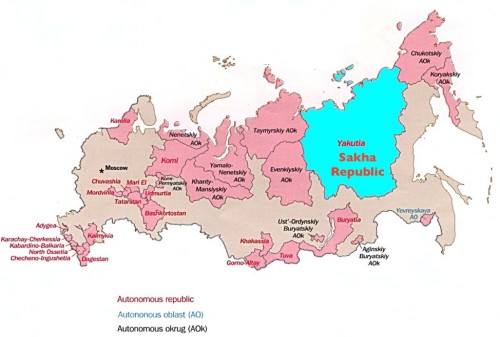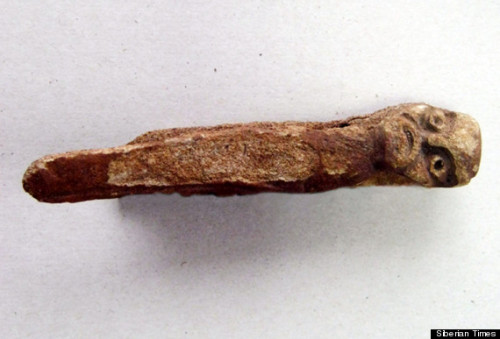Russian Republic Legalizes Neo-Pagan Faith
Russia, more often making headlines for repression of minority faiths, recently recognized the neo-Pagan faith Aar Aiyy as an official “religious organization” in the Siberian Russian Republic of Sakha. Religions with this special designation receive greater protections and privileges in Russia than those who are merely religious groups.

i Map courtesy of Geo Currents. Sakha (Yakutia) would be the world’s eighth largest country by area if it were independent.
Aar Aiyy appears to be a modern neo-Pagan revival of the indigenous shamanistic religion Tengrism. Tengrism flourished among the Turkic-speaking population of the Siberian Yakuts, the Turks, Huns, Mongolians, and Hungarians. In Siberia the religion waned in the 1600’s when Russian Orthodox Christians moved into the area. When Siberia was under Soviet control, all religions were suppressed but folk practices managed to survive into present time.
Aar Aiyy, meaning “belief in higher deities,” holds that there is one supreme God but also many spirits and other divine beings. Practitioners believe there are three worlds – the heavens, the world we know on earth, and the underworld.
According to a phone interview with Avgustina Yakovleva by the Moscow Times, adherents of Aar Aiyy have been working towards official recognition for 18 years.
Under Russian law, religions fall in one of three categories: a group, and organization, or a central organization. Central organizations are large religions that exist all over Russia such as the Orthodox church. Organizations are those who are stable in number, but may only exist in one location. Groups are informal, tiny and are not concentrated in one area. Unlike groups, both types of organizations are formally recognized and protected by Russian law. They also receive special privileges such as the ability to own land and build a place of worship, the use of public buildings for activities, the ability to form charitable groups and have centers for education, and the right to print and distribute information.
The road to moving from a group to an organization is difficult and takes a minimum of 15 years. Here are some of the requirements to form a religious organization:
- At least 10 citizens to found the organization who all live in the same town or rural area
- An application for registration
- A list of those who form the religious organization with an indication of their citizenship, their home address, and date of birth
- The charter of the religious organization
- Minutes of the constituent meeting which founded it
- A document issued by an organ of the local government and confirming that the said religious group has existed over the course of no less than fifteen years on the relevant territory
- Information on its basic creed and related practice, including the history of how the religion arose and a history of the said association. The forms and methods of its activity, its attitudes toward the family and marriage, toward education, particulars of its attitude toward the health of its followers, restrictions on the organization’s members and clergy as regards to their rights and duties as citizens
- A document confirming the location (legal address) of the of the newly formed religious organization
Even if a group completes all the steps, they can still be denied official recognition and protection. If authorities don’t believe the group is truly religious in nature, one of the founders is deemed incompetent, or the religion’s beliefs and practices are seen as incompatible with Russian law.
Siberian Fisherman Catches a God
According to The Siberian Times, “Nikolay Tarasov was fishing in a river near his home in Tisul, in the Kemerovo region of Siberia, when he caught something unexpected and very old.
“Me and a friend were walking on the river bank with nets, when suddenly it got stuck with something,” he said. “I found the object, freed the net and was about to throw it back in the water – but at the last second I looked at it more closely,” he said. “And I saw a face. I stopped and washed the thing in the river – and realized it wasn’t a stone of an unusual shape, as I thought earlier – but a statuette.”
The figure turned out to be a carved figure over 4,000 years old. The bronze age figure was originally carved in horn, but fossilized. According to Marina Banschikove, the director of the Tisul History Museum, the find is especially exciting as, “The only things we have dated approximately to the same age are a stone necklace and two charms in the shapes of a bear and a bird.”
Museum officials believe the figurine is that of a God from either the Okunev or Samus cultures. The figurine has almond shaped eyes and a large mouth with full lips. On the back side of the head there is plaited hair with wave like lines. Below the hair there are lines which look like fish scales.

Figureine of a bronze age God.
Photo credit – Siberian Times
The Samus culture existed around the 2nd millenia BCE in the western region of Siberia. They were known for living in half-dug-out dwellings and built monuments filled with ceramics, cast bronze armament and tools, and carved figurines.
The Okunevs lived around the same time, but were found in southern Siberia. The Okunevs created stone slab burial structures. They made lavishly decorated juglike and conical vessels and worked in bronze and copper. They were prolific stone carvers.
The Wild Hunt is not responsible for links to external content.
To join a conversation on this post:
Visit our The Wild Hunt subreddit! Point your favorite browser to https://www.reddit.com/r/The_Wild_Hunt_News/, then click “JOIN”. Make sure to click the bell, too, to be notified of new articles posted to our subreddit.

Good to see Aar Aiyy get recognition. May it and the Sakha themselves long prosper.
A truly awesome find!